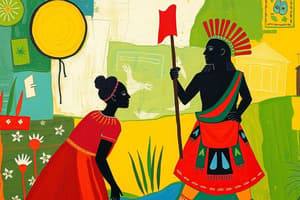Podcast
Questions and Answers
What percentage of the Philippines' population is estimated to be Indigenous Peoples?
What percentage of the Philippines' population is estimated to be Indigenous Peoples?
- 10% to 20% (correct)
- 5% to 10%
- 20% to 30%
- 15% to 25%
What is the main ethnic origin of the majority of people in the Philippines?
What is the main ethnic origin of the majority of people in the Philippines?
- Austronesian (correct)
- Chinese
- Spanish
- American
Which law supports the rights and cultural integrity of Indigenous Peoples in the Philippines?
Which law supports the rights and cultural integrity of Indigenous Peoples in the Philippines?
- Cultural Heritage Act
- Indigenous Land Act
- Republic Act 8371 (correct)
- Human Rights Act
What challenge do Indigenous Peoples in the Philippines primarily face?
What challenge do Indigenous Peoples in the Philippines primarily face?
What is one of the major reasons for the lack of implementation of the Indigenous Peoples Rights Act?
What is one of the major reasons for the lack of implementation of the Indigenous Peoples Rights Act?
What is the estimated percentage of people in the Philippines working in agriculture?
What is the estimated percentage of people in the Philippines working in agriculture?
Which of the following ethnic groups in the Philippines has the highest population percentage?
Which of the following ethnic groups in the Philippines has the highest population percentage?
What is one of the rights recognized for Indigenous Peoples under the United Nations Declaration?
What is one of the rights recognized for Indigenous Peoples under the United Nations Declaration?
What is a primary function of sociological theories?
What is a primary function of sociological theories?
Which of the following best describes macro-level theories?
Which of the following best describes macro-level theories?
What is defined as a philosophical and theoretical framework in sociology?
What is defined as a philosophical and theoretical framework in sociology?
How does a social group transition into a society?
How does a social group transition into a society?
Which factors contribute to holding a society together?
Which factors contribute to holding a society together?
What characterizes structural functionalism as a sociological paradigm?
What characterizes structural functionalism as a sociological paradigm?
Which statement accurately describes social scientists' contributions to sociology?
Which statement accurately describes social scientists' contributions to sociology?
Which of the following statements about sociological paradigms is true?
Which of the following statements about sociological paradigms is true?
Flashcards are hidden until you start studying
Study Notes
Indigenous Groups in the Philippines
- The term "indigenous" can be misleading when discussing the Philippine population, often implying alien migrant influences.
- A significant portion of the Filipino population descends from Austronesian ancestors, making many groups indigenous to the archipelago regardless of cultural affiliations.
- The estimated percentage of Indigenous Peoples in the Philippines ranges from 10% to 20% of the total population.
- The Philippines has adopted the United Nations Declaration on the Rights of Indigenous Peoples, although it has not ratified Convention 169.
- Republic Law 8371, or the Indigenous Peoples Rights Act (IPRA), was established in 1997, promoting cultural integrity, land rights, and self-directed development for Indigenous Peoples.
- Despite IPRA's supportive framework, Indigenous Peoples face challenges such as geographic isolation, limited access to social services, and restricted economic, educational, and political opportunities.
Ethnic Groups in the Philippines
- The Philippines is ethnically diverse, primarily composed of Austronesian origin groups, with some intermingling with European settlers.
- Key demographic breakdown by ethnic group:
- Tagalog (24%)
- Visaya/Bisaya/Binisaya (11%)
- Cebuano (10%)
- Ilocano (9%)
- Hiligaynon/Ilonggo (8%)
- Bikol (7%)
- Waray (4%)
- A significant portion of the population works in services, while roughly one-fourth is engaged in agricultural activities, especially in rural areas.
Sociological Theories and Concepts
- Sociologists analyze social events and interactions, developing theories to explain societal functioning.
- Sociological theories provide explanations for social phenomena and can generate testable hypotheses.
- Distinctions in sociological theories include:
- Macro-level theories: address large-scale societal issues and groups.
- Micro-level theories: focus on specific relationships between individuals or small groups.
- Grand theories: attempt to explain fundamental societal relationships and changes.
- Sociological paradigms serve as philosophical frameworks for developing theories and conducting research, with three dominant paradigms:
- Structural functionalism: examines society's structure and each component's role.
- Conflict theory: focuses on social conflicts and power struggles.
- Symbolic interactionism: explores how individuals construct meanings through interactions.
Social Groups and Society
- Human beings form social groups and institutions for mutual support and survival through interaction.
- Certain factors contribute to societal cohesion, and the transition of social groups into cohesive societies involves shared norms and values.
- Understanding society and social behavior has been enriched by various contributions from social scientists over time.
Studying That Suits You
Use AI to generate personalized quizzes and flashcards to suit your learning preferences.



